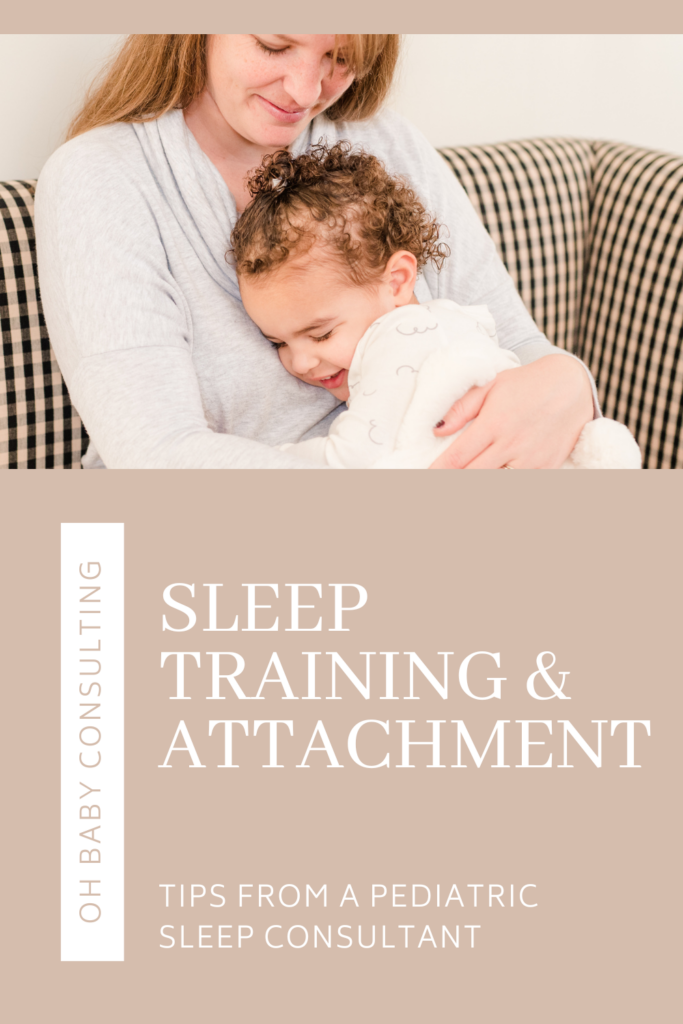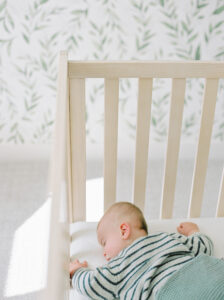Baby sleep is such a hot-button topic, and approaches to baby sleep are passionately debated on social media, in mom’s groups, and even within families. Oftentimes the arguments against sleep training include things like “sleep training damages the attachment relationship” and “I’m more of an attachment parent so sleep training goes against what I believe”.
While sleep training is a deeply personal choice and is certainly not the path for every family, it’s so important to recognize that sleep training & having a secure attachment with your child can coexist. They are not mutually exclusive. In fact, believing that you must choose one or the other imputes a very limited view on both sleep training and attachment theory.
If you don’t read anything else, here’s what I need you to know:
- Attachment parenting is not the same as attachment theory: you can raise a child who is securely attached without prescribing to all attachment parenting practices.
- There is zero relationship between the security of attachment & how your child sleeps.
- Attachment is a sophisticated process that cannot be damaged through sleep training.
- Reducing the attachment relationship down to a “checklist” is erroneous & offensive.
- Most often, parents feel that the byproducts of sleep training serve to strengthen their attachment as they are able to be more in tune with their child & show up more presently for them.
One of my primary missions at Oh Baby is to combat misinformation related to parenting & sleep. Given my academic background in child development & infant mental health, I am committed to providing information that is evidence-based, peer-reviewed-research backed, and not click-bait-y headlines.
So, here’s what you need to know about attachment parenting, raising a securely attached child, and how it all relates to sleep training.
What is attachment parenting?
Attachment parenting is a parenting philosophy that was popularized by Drs. William and Martha Sears in their 1993 publication, “The Baby Book.” The idea, in a nutshell, is maximum closeness and responsiveness. You wear your baby, you share a bed with your baby, you breastfeed on demand, and you answer their cries immediately. In theory, this creates a strong attachment between a mother and her baby which results in well-adjusted children who are therefore protected from any negative effects of the world around them.
The whole premise of attachment parenting is that you build a strong attachment with your child through a list of core behaviors. Dr. Sears actually created a catchy bullet-point list of the principles of attachment parenting that he refers to as “The Seven B’s.”
- Birth Bonding
- Breastfeeding
- Baby Wearing
- Bedding Close to Baby
- Belief in the Language Value of Your Baby’s Cry
- Beware of Baby Trainers
- Balance
Here’s my take: I think there are a lot of well-studied benefits of some of the principles of attachment parenting: we know that postpartum skin-to-skin in a wonderful bonding experience for both mother and baby; we know that there are many benefits to breastfeeding; we know that baby-wearing can help ease the transition into the fourth trimester; we know that sleep training is not right for every family.
But here’s what else we know: not every mother is able to do skin-to-skin with their baby immediately following delivery; not every mother is able to or wants to breastfeed; being “touched-out” is valid & parents may need a break for their own mental health; sleep deprivation is dangerous and disruptive and sleep training is a reasonable solution.
Are parents who fall into the latter group doomed to have babies who will not be securely attached?
HECK NO.
Attachment cannot be simplified into a 7-point, alliterative checklist.
There is actually no peer-reviewed research at all on attachment parenting. It’s not an intervention that has been studied and proven to be a more effective parenting practice than any other parenting styles. But there are numerous studies on attachment theory and the science behind that.
What is attachment theory?
Attachment parenting is different than attachment theory and building a secure attachment, so let’s break down what attachment theory is.
To understand attachment theory, it is helpful to understand the context in which it came about. Attachment research was pioneered by John Bowlby and Mary Ainsworth. Bowlby was interested in the impact of separation on children who had been removed from their parents during wartime, and his student – Mary Ainsworth- was interested in diving deeper into the relational observations she had made while studying mother-child dyads in Uganda. Ainsworth was fascinated by the behavior of babies who were using their mothers as a “secure base” as they went out and confidently explored their surroundings.
Together, Bowlby & Ainsworth conducted a series of experiments they coined “The Strange Situation” where babies were briefly separated from their parents and left in the care of a stranger and then observed upon reunion. Out of that, a series of classifications of degree of attachment were concluded. It was found that most (above 60%) of babies across cultures were securely attached.
What is important about this finding is that while most babies were securely attached, there was a wide variety in parenting practice within that group. Not all mothers breastfed. Not all mothers practiced baby-wearing. Not all mothers co-slept.
So immediately we can debunk the theory that you must do a list of precise things in order to have a securely attached child.
What is secure attachment?
Secure attachment is not about constantly being close to your child, but rather your child developing a generalized trust in your “being there” for them. This allows them to confidently explore their environment and then return and “check in”. These babies know that they have a loving caregiver still available, even though they weren’t right there. So, building a secure attachment is really more about babies developing independence and confidence without being physically connected to a parent.
Healthy attachment is not based on a list of things you do; rather, it is built on a series of ongoing experiences with your child that is full of mismatches and repairs. It does not rely on you being next to your child at all times or rushing to their side with immediacy every time they make a noise. In fact, research shows that 30-50% of attunement is “good enough” – meaning that up to 70% of the time, you can have a mis-attunement and still have a child who is securely attached. Being attuned to your child 24/7 is exhausting, unrealistic, and – as research shows – unnecessary.
Additionally, positive stress (even when it involves crying) is not inherently problematic or some sort of bad thing to be avoided. In positive stress situations, children are able to learn resilience through tolerable levels of stress & develop coping skills that will become part of their emotional regulation toolbox.
But attachment fear-mongering is real, and for many parents, they worry that making sleep changes will result in damages to the attachment relationship. But the opposite is often true: parents who choose to sleep train usually report that they feel like their relationship with their child improves once everyone is sleeping better.
How can sleep training improve attachment?
While how your child sleeps is not related in any way to the security of their attachment, there is ample research pointing to the correlation between maternal health & wellness and secure attachment.
For example, Mary Ainsworth found that it wasn’t whether a mother was breastfeeding, but her feelings about breastfeeding that were related to secure attachments. Additionally, we know that sleep deprivation is linked to poorer maternal mental health and that well-rested mothers have less depressive symptoms and are better able to connect with, be in tune with, and respond appropriately (vs. chaotically) to their babies. This type of reciprocity is the basis for building strong attachments.
(Note: I’m sure the same is true for fathers, but the research there isn’t as robust yet!)
So ultimately fostering a secure attachment with your child comes down ensuring that you as the parent are at your mental best – whatever that looks like in your family.
Broken sleep makes everyone feel miserable. (Though there is research to back that up, you don’t really need a study to tell you that.) And because we know undoubtedly that sleep training is safe, if you’re in an unsustainable sleep situation, finding sleep solutions that work better for your family is going to be more predictive of building a secure attachment than following a list of B-words.
At the end of the day, it’s all about what works for your family.
Your baby can have healthy attachment if you sleep train.
Your baby can have healthy attachment if you don’t sleep train.
The best way to raise a securely attached child is to make sure that your parenting practices are aligned with your family’s values and what works for your family unit. And remember that what works today may not work next week. You are not bound to one way – you can make a change when something is no longer working for you.
So, while sleep training is not the right choice for every family, it is a valid and safe option that will not negatively impact your attachment.
And if you’re looking for a plan + support in making a change, please reach out.














